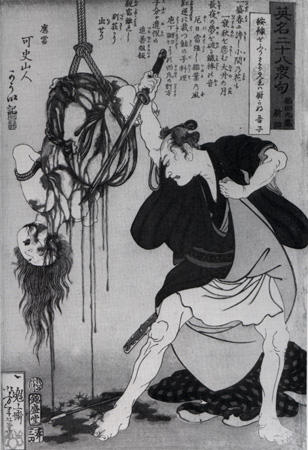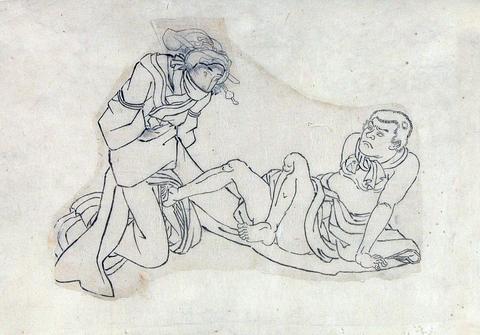PUNISHMENT AND THE BEAUTY OF JAPANESE BONDAGE (KINBAKU)
The History of S&M in Japan
S&M Art has taken many forms in Japan and this relates directly
to the history of Japan. One established genre of S&M art in Japan
is what is known as the Joshu or female prisoners stuff. When we say
"female prisoners" or "Joshu" stuff, we generally
refer to those pictures of torture from the period between the battle
of Onin (1467) throughout Sengoku and Edo periods to Meiji. Sengoku
period is noted for its cruel methods of torture - fire, knife (to cut
off parts of the body), tattoo, rocks, boiling water, divining blocks
and rocking horses, and so on and so on. The most brutal forms of execution
and torture were employed during this period of hell on earth. The methods
of torture and execution used against the Christians were most barbaric.
It should be noted, however, that there is nothing uncommon about brutal
religious prosecutions throughout history. Elsewhere the believers of
'wrong' religions have been treated separately from the rest of the
population. Christians in Japan got their ears, fingers and noses chopped
oft, which were originally punishments for those who committed the crime
of treachery and deceit. It was meant to give maximum public humiliation
by physical deformation.
The Tokugawa government laid out in 1742 the foundation of crime laws,
which spelled out seven different types of punishment - death, exile,
slavery, forced labour and so forth, as well as four kinds of torture
- .whip (mutchiuchi), pressing stone (ishidaki), bend by rope (ebizeme)
and hung by rope (tsurizeme). It has to be noted that all four official
methods of torture from this period ore still considered the main stream
torture patterns in the S&M ort today. You could say the foundation
of today's S&M art was laid down then.

The other interesting aspect of punishment in this period is public
disgracing. Public disgracing of criminals and public execution was
common before a Yamato dynasty was set up in Nara in 794. The execution
of women was not open to the public then but became acceptable during
Edo period. According to "History of Punishment in Japan" (Takigawa Masajiro), criminals were tied to a horse and dragged around
the city with a note describing the crime. The author noted that women
criminals aroused the perverted interests among the male on-lookers.
The purpose of public disgracing was to deter ordinary folks from committing
crimes by indicating the consequence, as well as to humiliate the criminals
to the maximum. Women suffered more from public disgracing, which is
a dominating theme behind today's bondage art.
Japanese society became more stable following the reign of Ietsuna and
Tsunayoshi, fourth and fifth Tokugawa shoguns, and acts of punishment
became more theatrical. At the height of Edo culture, depiction of punishment
had become a genre and punishment became increasingly popular as a form
of mass entertainment with a tinge of agitation. The artistic characteristics
of today's S&M, especially Joshu stuff and bondage, stem significantly
from this period,
The actual act of torture and punishment is almost always carried out
by the lower class officials. During the Edo period, when the social
hierarchy was established, catching the criminals was the job assigned
to the lower class officials such as Yoriki and Doshin. Meakashi and
Okappiki who are frequently featured in today's period novels were private
detectives, official status being "merchants", employed by
Doshin.
Binding up with rope was the art developed and maintained by Doshin,
because different roping was required for people from a different class.
Roping up wrongly would embarrass not just the criminals but also the
officials. Some roping techniques have only been handed down orally
or were kept secret.

Public humiliation and the authorities
There is an element of public ridicule of authority in the S&M art.
Take an example of a pre-war picture which depicts the wile of the reactionary
man being tortured and raped by a thought police officer. One from the
Edo period shows female prisoners shamed by a local constable. A more
modern example shows a male department store attendant toying with the
body of a school girl who was caught shoplifting. Another shows a female
office worker getting raped by a station master who caught her fare
cheating.
In these pictures, the act of raping and torture is "justifiable"
because their victims did wrong. You can say there is a tinge of sadism
involved. The victims accept the crime and punishment. yet still tremble
from the sheer humiliation. The social position of women in these pictures
is so fragile that it amplifies the power balance between the aggressors
and the tortured. The frailty, weakness and these characteristics of
women ore presented here many times multiplied, They arouse the sense
of shame even more and stimulate the masochistic appetite, No ordinary
rape S&M art could attain this.
Still, you could not categorise all people who get excited by these
pictures as sadists. They might be excited by sympathising with tortured
and raped girls in these pictures.
In other words, they might feel satisfied with sharing the tremble of
the body, an accelerating heart beat and a wet crotch from the fear.
This does not mean that they are all masochistic either. Indeed, this
is where the fine line between S&M lies.

S&M magazines during the Post War period
"The only recognition I ever received, as a person who has studied
bondage since 1908, was the pervert tag" said Ito Seiu in an article
published in Amatoria magazine in 1953. During his time, the word S&M
was not even in the public usage - it was all swept under the carpet
and the purveyors were called perverts.
When Ito wrote this, in the early fifties, it was at the time when post-war
pulp magazines were transforming into more mass market oriented erotic
journals. It was indeed in 1953 when one of those pulp magazines, Kitan
Club, transformed into an authentic "abnormal" magazine. Kitan
Club, when launched in 1948, was an ero-thetic magazine aimed at the
"normal" people. The transformation was sparked by series
of bondage pictures by Kita Reiko - who is also known as Suma Toshiyuki,
the magazine editor of Kitan Club and Uramado, and a novelist under
the name of Minomura Ko. He claimed to be the "last disciple of
bondage master, Ito Seiu".
"Yomikiri Romansu" was another magazine full of B-grade erotic
novels with the format similar to then popular "Married Couples"
magazine. The Romansu magazine had bondage photos and pictures by the
editor, Ueda Seishiro, who was influenced heavily by Ito Seiu. Ueda
was a regular at photo sessions organised by Ito. Many bondage photos
from these sessions ended up on the pages of fledging S&M magazines
such as Kitan Club and Uramado. You could say the spirit of Ito Seiu,
the great roping master, is handed down to the present day via these
magazines of the fifties.
The Uramado magazine was launched in 1955. Initially a magazine of period
novels, it transformed into an S&M magazine around 1960 due largely
to the effort of Iida Toyokazu, ex-editor of Kitan Club. Iida later
became the major contributor, known as master roper Nureki Chimuo, to
the golden days of S&M magazines in the seventies and to the rise
of S&M videos later.
With all new directions and designs, Uramado proclaimed on the cover
to be "the most extraordinary S&M magazine in the country".
The magazine nurtured talented photographers like Yoshida Kyu and Fujisawa
Shu and artist, Nakagawa Ayako. The magazine also printed lots of photos
and pictures imported from overseas via Phoenix Co.
Morishita Takashige of Phoenix had contacts with many "maniacs"
and "collectors" of the US West Coast, such as John Willy
and Fakir Musafar, then the publisher of Fancy, the world's first modern
primitive magazine. Incredibly, Musafar had already paid a visit to
Japan and was introduced by Kanta Mori (Morishita) as an exponent of
anomalous piercing mania, in Fuzoku Kitan magazine.
Unfortunately Uramado crashed in the mass suppression of similar publishers
in the 60s. The demise of Uramado signalled the end of a golden era
of "abnormal" magazines in the post war period. Maybe it was
not acceptable yet to proclaim S&M media openly. The second heyday
of the S&M magazines arrived in the early 70s through to the eighties,
which spawned out titles like SM Collector, SM Select, SM Kitan, SM
Mania, SM Fan, SM Sniper and SM King.

Pornography and S&M
The subtle differences existing in the S&M art, and the differences
in various magazines, are hard to explain to a novice. To the eyes of
many they all look the same; victimisation of women. There are roughly
two streams in the S&M art in Japan; ones depicting the dark aesthetics
of S&M and the others, much lighter and more pornographic. One should
remember it was only since Dan Oniroku wrote a novel "Flower and
Snake" that the vagina became more prominent and vibes and enemas
for anal penetration were added to the S&M art.
So-called soft core S&M and S&M clubs today are the products
of the second stream. It is obsessed with vagina, cunt and anus, women's
private parts which were not regarded important in the traditional S&M
art. In this new and popular form, "S&M" is just foreplay,
downgraded to a mere entree to the main act of sexual intercourse. It
is certainly not seen as pursuit of aesthetics. There is nothing wrong
with physical intercourse, but S&M art is not a part of it. Popularised
S&M is not the real thing because it does not thrive in the pursuit
of the art of torture.
Copyright by Masami Akita
If you are interested in the history of bondage photos from the post
war period, please look for my publication, "History of bondage
photos of Japan (Nihon KinbakuShashin Shi)" published by Jiyu KokuminSha.
It has three hundred illustrations.
There are 2 old images, showing early japanese (non
consensual) bondage technics:

The first is a famous piece by Yoshitoshi from his album "Twenty-eight
famous murders with poems" from 1867. No, I'm not kidding about
the title. :) It was a very well known and shocking series of Ukiyo-e
prints that depicted famous crimes and crime stories of the day all
done in brilliant color with special attention to getting the blood
red correct.

The second piece is what's called a "dessin" or preparatory
sketch for a print or painting and could be by Kuniyoshi but it's tough
to tell at long range and with so faint an image.
(With kind permission of Steve I. and Master K.)
Back to History Index




